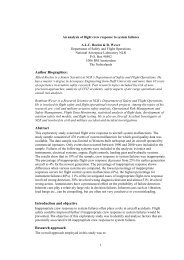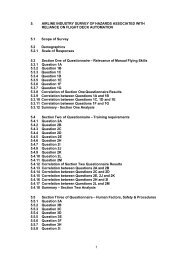Causal risk models of air transport - NLR-ATSI
Causal risk models of air transport - NLR-ATSI
Causal risk models of air transport - NLR-ATSI
You also want an ePaper? Increase the reach of your titles
YUMPU automatically turns print PDFs into web optimized ePapers that Google loves.
Confusion between causation and statistical associations<br />
Post war diseases<br />
War syndromes have been associated with armed conflicts at least since the U.S. Civil War<br />
(1861-1865) but research efforts to date have been unable to conclusively show causality<br />
[Hyams et al 1996, Jones et al 2002]. Explanatory causes that were proposed have varied<br />
from the heavy marching packs compressing the chest (U.S. Civil War 1861-1865, Boer<br />
War 1899-1902) to concussion from modern weapons (World War I 1914-1918), the use <strong>of</strong><br />
Agent Orange (Vietnam War 1957-1975) and the use <strong>of</strong> depleted uranium in armour<br />
penetrating ammunition (Persian Gulf War 1991).<br />
Health effects <strong>of</strong> electromagnetic fields<br />
Concern about possible adverse health effects from exposure to extremely low-frequency<br />
electric and magnetic fields (EMF) emanating from the generation, transmission and use <strong>of</strong><br />
electricity was first brought about by an epidemiologic study concerning a relation between<br />
<strong>risk</strong> <strong>of</strong> childhood leukaemia and exposure to EMF [Wertheimer & Leeper 1979]. But a<br />
more recent review <strong>of</strong> the epidemiologic literature on EMF and health concludes that in the<br />
absence <strong>of</strong> experimental evidence and given the methodological uncertainties in the<br />
epidemiologic literature, there is no chronic disease for which an explanatory relation to<br />
EMF can be regarded as established [Ahlbohm et al 2001].<br />
These examples demonstrate why inferring causal relations requires subject-specific<br />
background knowledge. It is therefore essential for developers <strong>of</strong> a causal model <strong>of</strong> aviation<br />
safety to have substantial knowledge on all relevant aspects <strong>of</strong> aviation, including<br />
technology, operations, regulation and procedures for the complete lifecycle. Absence <strong>of</strong><br />
subject matter knowledge will lead to causal <strong>risk</strong> <strong>models</strong> that produce misleading results.<br />
Going back to the example <strong>of</strong> post war diseases, it is easy to imagine how ineffective or<br />
even counterproductive treatments will be prescribed if any one <strong>of</strong> the above mentioned<br />
cause effect relations are reproduced alone in, say, a diagnostic model.<br />
Indeed, statistical associations can be hopelessly confusing, as is illustrated by Simpson’s<br />
paradox. Simpson’s paradox refers to the phenomenon whereby an event C increases the<br />
probability <strong>of</strong> E in a given population p and, at the same time, decreases the probability <strong>of</strong><br />
E in every subpopulation <strong>of</strong> p. For example, in Table 1, if we associate C (connoting cause)<br />
with taking a drug, E (connoting effect) with recovery, then the drug seems to have no<br />
beneficial effect on both males and females compared to no drug and yet is beneficial to the<br />
population as a whole.<br />
Table 1: Simpson’s paradox.<br />
Combined Effect No effect Recovery rate<br />
Drug 20 20 50%<br />
No drug 16 24 40%<br />
Males Effect No effect Recovery rate<br />
Drug 18 12 60%<br />
No drug 7 3 70%<br />
Females Effect No effect Recovery rate<br />
Drug 2 8 20%<br />
No drug 9 21 30%<br />
25




